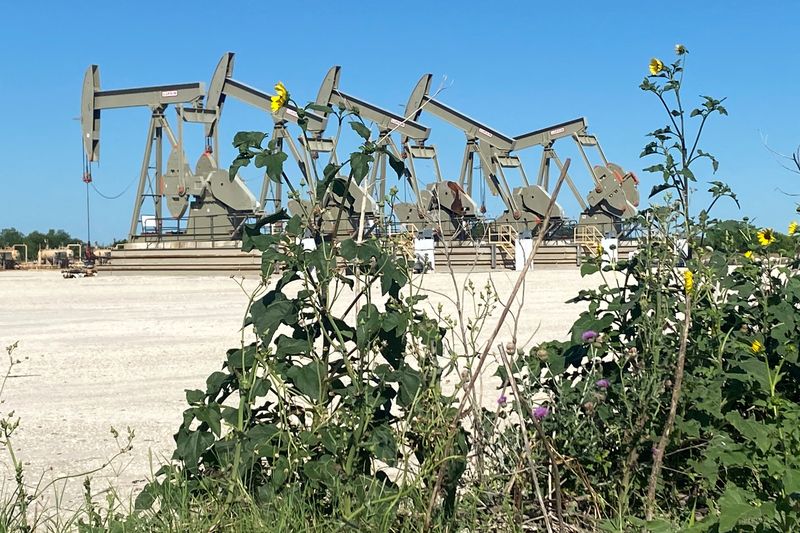Commodities
Gold snaps five-week win streak, but bull run not over yet: MS

Investing.com — Gold snapped a five-week wining streak Friday, but the yellow metal’s bullish run likely isn’t over yet as tailwinds including central bank demand have more room to go just as the tide of outflows from gold exchange traded funds are starting to turn.
Gold prices rose 0.3% to $2,348.75, but took heavy losses earlier this week following easing Middle East tensions after Iran-Israel showed little appetite to escalate their tit-for-tat exchange.
The path ahead for gold prices is set to be choppy but likely leans toward higher highs, rather than a reversal, Morgan Staley said, forecasting the odds are more in favor of its bull case scenario, which sees gold rising to $2,760 an ounce in the second half of the year, rather than its bear case scenario of a fall to $2,000 an ounce.
The strength in the demand for the yellow metal has provided it with extra clout to withstand the weight of rising real interest rates, which have a long history of hampering investor appetite for non-interest bearing assets like gold.
Gold is typically expected to have a “negative correlation with real yields, given it loses relative competitiveness in investor portfolios as real yields rise,” Morgan Stanley said, but is now showing a positive correlation with real yields on a 3-month basis as fundamental drivers have been dominating price action.
Central bank purchases of bullion, led by People’s Bank of China, demand for safe havens amid rising geopolitical tensions, and growing demand for an inflation hedge have helped kept gold on the up, and up.
remove ads
.
These bullish factors, particularly central bank buying, aren’t likely to disappear anytime soon.
Gold consumption in China rose 5.94% from a year earlier to 308.91 tons in the first quarter of the year, China Gold Association said Friday, driven by soaring safe-haven demand.
The PBoC bullion purchases continued for a 17th straight month in March, taking its total gold reserve to 2,262.67 tons by the end of Q1, according to the China Gold Association.
Meanwhile, ETF demand has been weak throughout gold’s rally as outflows have continued, but the tide of outflows are “starting to turn,” Morgan Stanley said.
U.S. and Asia ETFs have seen inflows since mid-March, according to the World Gold Council, but that has been offset by outflows in Europe.
While these fundamental positive drivers show no sign of cooling, the macroeconomic outlook, in which U.S. inflation appears to be more sticky, keeping rates higher for longer, has some doubting gold’s next move higher.
“But if data stays strong, driving concerns of more sticky inflation, as well as elevated geopolitical risk, gold may stay well bid regardless,” Morgan Stanley said, adding that if a rate-cut is brought forward that is often another positive catalysts for gold.
Commodities
This indicator says oil prices will bottom soon: analysts

Oil prices are set to form a bottom in the coming months, McClellan Financial Publications analysts argue.
Recent gold price trends, adjusted forward by 19.8 months, can be compared to prices, a shift that aims to highlight how gold’s price movements tend to echo in oil prices after that specific interval.
While not a flawless model, it generally provides strong accuracy, the report states. Occasionally, discrepancies occur, such as when Russia’s invasion of Ukraine disrupted the oil market. However, after each such divergence, prices consistently strive to realign and return to their historical correlation.
“Coming up, this model says that we have a bottom due in mid-2024, followed by a rise toward the end of the year,” The McClellan Market Report says.
“That oil price rise is not going to be good news for any federal politicians who may be running for reelection in November. And if the recent rally in gold prices (just off the right end of this chart) keeps going higher, that is going to mean higher oil prices 19.8 months later,” it added.
In late 2023, crude oil prices declined earlier than expected, missing the predicted peak that gold price movements had indicated would occur later that year. However, oil prices have since realigned with the pattern, the report highlights.
The forecast indicates that the forthcoming bottom will ideally occur around June or July 2024. That said, it’s worth noting that turning points might not precisely follow this timeline and could occur slightly earlier or later.
remove ads
.
The key takeaway is that a bottom is expected, though more price declines may occur before reaching that point.
“Then as summer gets closer, we should turn to other indicators to home in on signs that the price bottom for oil is arriving, and/or that an upturn is starting,” the report notes.
Commodities
Oil prices set for positive week on demand hopes, Middle East tensions

Investing.com– Oil prices rose Friday, on track for a positive week, after signs of demand growth in both the U.S. and China, while tensions remained strained in the Middle East.
At 08:40 ET (12:40 GMT), rose 0.5% to $84.26 a barrel, while gained 0.6% to $79.73 a barrel.
Oil heads for weekly gains
Both benchmark contracts were set to post gains of around 2% this week, boosted by stronger-than-expected overall data from China, the world’s biggest oil importer. Signs of strong domestic demand pushed up hopes that oil demand will start picking up in the Asian giant.
China’s oil imports added to the positive overall tone as well, as although imports fell from the prior month, they came in above the levels seen last year.
Additionally, inventories surprisingly fell last week, and refining and fuel demand is set to increase tracking higher travel demand during summer.
“EIA data shows that U.S .commercial crude oil inventories fell by 1.36m barrels over the last week, different to the 500k barrel build the API reported,” analysts at ING said, in a note.
“The decline in crude oil stocks was driven by stronger exports, which increased by 550kk b/d WoW to 4.47m b/d, and stronger refinery activity.”
Israel-Hamas ceasefire appears unlikely, tensions high
Israel has continued its assault on the South Gaza city of Rafah, even as Hamas said the assault largely undermined ceasefire talks.
The attacks persisted even as the U.S. said it will suspend weapon shipments to Israel over the Rafah strikes.
remove ads
.
The Rafah strikes pointed to sustained geopolitical unrest, resulting a risk premium remaining alive in crude markets, given that geopolitical unrest in the Middle East could potentially disrupt supplies from the crude-rich region.
OPEC+ to roll over cuts?
Also supporting prices this week has been talk that the Organisation of Petroleum Exporting Countries. and allies, known as OPEC+, will continue to roll over output cuts, in an attempt to limit global supply.
“OPEC+ members will also become uncomfortable if starts flirting with $80/bbl, a level which is not too far away,” ING added.
“As we have mentioned previously, price weakness increases the likelihood that OPEC+ members will fully rollover their 2.2m b/d of additional voluntary cuts into the second half of the year, which risks overtightening the market later in 2024, assuming no downside surprises on the demand side.”
(Ambar Warrick contributed to this article.)
Commodities
Oil benchmark Brent above $84 on perky demand signals, MidEast conflict

By Natalie Grover
LONDON (Reuters) -Global benchmark hovered above $84 a barrel on Friday after data this week signalled growing demand in the U.S. and China, the world’s two largest crude users, while festering conflict in the Middle East added support.
Brent futures were up 50 cents to $84.38 a barrel at 1130 GMT. U.S. West Texas Intermediate crude climbed 57 cents to $79.83.
Falling inventories spurred by higher refinery runs coincided with data released on Thursday showing China’s oil imports in April were higher than last year on signs of improving trade activity.
China’s exports and imports returned to growth in April after contracting in the previous month.
“Ongoing signs of strength in demand in China should see commodity market remain well supported,” ANZ Research analysts said in a note.
Focus is also on U.S. inflation data – due next week – which could affect the Federal Reserve’s interest rate policy path.
In Europe, a Ukrainian drone attack set an oil refinery in Russia’s Kaluga region on fire, RIA state news agency reported on Friday, the latest salvo from Kyiv in what has become a series of tit-for-tat attacks on energy infrastructure.
Meanwhile, conflict in the Middle East continues, after Israeli forces bombarded areas of the southern Gaza city of Rafah on Thursday, according to Palestinian residents, after the latest round of negotiations to halt hostilities in Gaza came to naught.
As the conflict rages, it increases the potential for a broader conflagration in the region, particularly Palestinian group Hamas’ main supporter Iran, a key oil producer.
remove ads
.
“Israel’s groundwork for an intervention in Rafah and growing tensions on its Northern border are a reminder that geopolitical risks could persist through all of Q2 2024, at least,” Citi analysts said in a note.
Still, the bank sees prices easing through 2024, with Brent averaging $86 a barrel in the second quarter and $74 in the third quarter amid signs that global oil demand growth “appears to be moderating”.

 Forex2 years ago
Forex2 years agoForex Today: the dollar is gaining strength amid gloomy sentiment at the start of the Fed’s week

 Forex2 years ago
Forex2 years agoHow is the Australian dollar doing today?

 Forex1 year ago
Forex1 year agoUnbiased review of Pocket Option broker

 Forex2 years ago
Forex2 years agoDollar to pound sterling exchange rate today: Pound plummeted to its lowest since 1985

 Cryptocurrency2 years ago
Cryptocurrency2 years agoWhat happened in the crypto market – current events today

 World2 years ago
World2 years agoWhy are modern video games an art form?

 Stock Markets2 years ago
Stock Markets2 years agoMorgan Stanley: bear market rally to continue

 Economy2 years ago
Economy2 years agoCrude oil tankers double in price due to EU anti-Russian sanctions

































